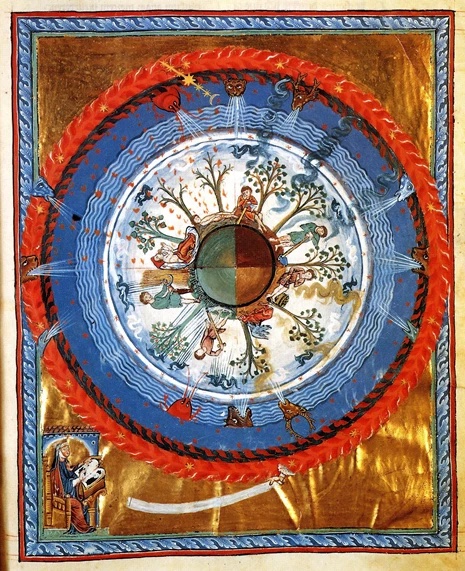Hildegard von Bingen (1098-1179) was born in Germany during the Middle Ages, at a time when education and literacy were controlled by the Catholic Church. She was an abbess, visionary, prophetess, herbalist, philosopher, healer, writer, politician, poet, and composer.
Despite her claim of lacking formal training in either the Latin language or music, Hildegard produced songs that were equal to those written by the most admired men of the Middle Ages. A woman of letters, she often communicated directly with clergy of the church, including Pope Eugene III, who encouraged her to continue writing music and poetry. She went on to write several books about religion, art, politics, philosophy, science, medicine, and herbs.
Hildegard had visions that she called “reflections of the living light,” and she painted what she saw. She suffered from headaches and some scholars of her writing suspect that she may have She had many visitors at the abbey who claimed that she was able to heal them though touch and with her knowledge of herbal medicine. In time, she had so many visitors, that a larger venue was needed. The church relocated her to an abbey of her own, in Bingen, where she was able to attend to more people. She died there at the age of 81.
How does Hildegard’s music sound on harp?
Originally composed monophonically (or single line melody), Hildegard’s music is usually found as sung choral music. As Latin was written language of the day, her songs reveal a devotional poems. Scales of these songs are modal (most often in Dorian, Phrygian, and Mixolydian modes), the earliest of Western music keys.
I was first introduced to Hildegard’s music as a teenager, and then later in college. When I studied to become a Certified Clinical Musician, I found her music inherent therapeutic. There simple nature was beautiful to me, but I had trouble finding harp arrangements of her songs. So, I set out to arrange some of the tunes myself.
I didn’t seek to make harp arrangements of Hildegard von Bingen’s music overly complex. Because I had the therapeutic musician in mind, I knew these harpists will have a small harp, or a folk harp. I wanted to make this music accessible for as many people as possible, so that if the goal was to play for people with physical, mental, or sleep ailments, they could do that with the harp size available to them.

Some songs I thought could become more complex, so I wrote a second arrangement. You will see this in the forthcoming book, Songs of Hildegard von Bingen for Harp, with five songs. In those second arrangements, there exists low bass notes (for the large harp), sophisticated chords that one didn’t hear in the Middle Ages, or space for improvisation and looping of chord progressions.
Updated: Songs of Hildegard von Bingen is now for sale!
As of De. 2024, Songs of Hildegard von Bingen for Harp is now available as a book from Mel Bay Publications! After two years of work arranging twenty of Hildegard’s Gregorian Chants for Harp, the book of sheet music, “Songs of Hildegard von Bingen for Harp” is available now!
Please stay tuned for announcements of more book release news, “Songs of Hildegard von Bingen!” You can sign up for my newsletter and follow me on YouTube for new releases the Hildegard von Bingen songs.